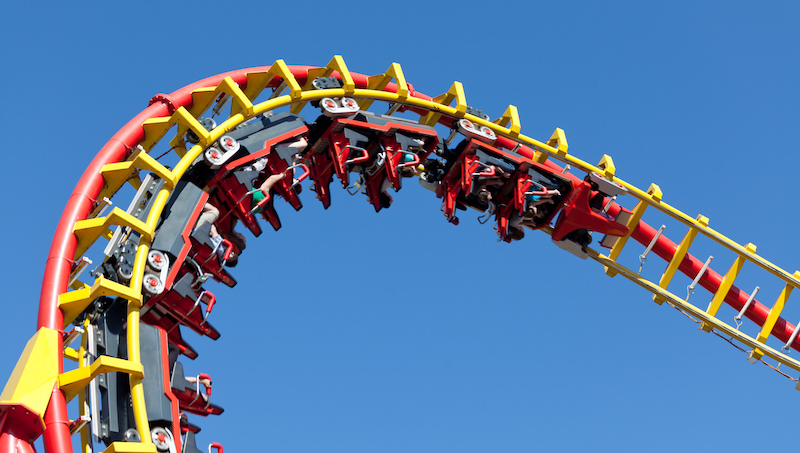
Commentator argues that amusement parks can do more to expand access to disabled individuals.
Amusement parks are filled with disappointed children who do not meet the minimum height requirements necessary to ride rollercoasters. Unlike most children who can find comfort in knowing that one day they will be tall enough to ride, for the disabled, “no” typically means “never.”
In a recent paper, William Moorer, a law student at the University of Mississippi School of Law, argues that even though manufacturer ride restrictions are legitimate safety requirements for the disabled, amusement park owners should find safe ways to increase rider accessibility.
The federal Americans with Disabilities Act (ADA) requires places of public accommodation to provide patrons with reasonable opportunities for the “equal enjoyment of the goods, services, facilities, privileges, advantages, or accommodations of any place of public accommodation.” The ADA’s “safe operation exception” permits owners to create restrictions that exclude disabled individuals as long as the restrictions are driven by legitimate safety requirements or the disabled individuals would pose a threat to the health or safety of others.
As a result, disabled amusement park patrons often must confront rider restrictions developed by ride manufacturers and implemented by park operators.
As much as Moorer favors increasing access to amusement park rides to the disabled, he acknowledges that ride restrictions imposed on disabled people are generally valid and do not violate the ADA. But he argues that steps should be taken to ensure that amusement park owners do not exclude disabled individuals altogether. Instead of focusing on a disabled person’s eligibility to experience specific rides individually, Moorer contends that a more constructive approach would be to consider the amusement park experience as a whole.
The United States District Court for the Middle District of Florida took this approach in A.L. v. Walt Disney World Parks when it interpreted Congress’s intent in creating the ADA. It reasoned that Congress meant to provide disabled individuals access to an “equal experience” so that “all individuals have an equal opportunity to gain ‘a like’ or ‘equal’ benefit.” The court ultimately held that Disney had given the handicapped plaintiff an equal opportunity to experience Magic Kingdom through its Disney Disability Access Service, which provides a scheduled return time for those who are not capable of standing in lines for park attractions.
In addition to requirements under the ADA, the Architectural and Transportation Barriers Compliance Board creates separate access guidelines. For example, the Board requires at least half of all available holes on miniature golf courses to comply with accessibility standards. Through a holistic approach, the Board evaluates compliance based on whether or not the facility’s owners have maximized the opportunity for handicapped individuals to participate.
Moorer argues that instead of testing amusement park compliance through a ride-by-ride approach, compliance should be measured based on the amusement park experience as a whole. Because many attractions at amusement parks comply with the ADA, a holistic view would determine ADA compliance based on the quality of the amusement park experience, rather than a disabled person’s experience with one particular ride.
Critics might argue that a holistic approach is not judicially manageable. For example, the U.S. Court of Appeals for the Ninth Circuit ruled in Oregon Paralyzed Veterans of America v. Regal Cinemas that front row seats reserved for disabled moviegoers did not constitute “equal enjoyment” of the movie theater because it resulted in neck strain.
But in Fortyune v. American Multi-Cinema, the court held that a movie theater that provides accessible seating for a wheelchair-bound moviegoer, but did not provide an adjacent seat for his wife, nonetheless complied with the ADA.
Where and how should a court draw the line under a standard that looks to a customer’s holistic experience?
A holistic approach may not always produce results favorable to handicapped plaintiffs, like in Fortyune for example. On the other hand, the holistic approach may place too high of a burden on institutional actors such as recreational boating or fitness facility owners, who might worry that these judicial holdings could extend to situations that cannot be easily remedied. Even a developmental disability cruise service provider failed to convince a court to dismiss a plaintiff’s claims that it had not reasonably accommodated its guests, despite its earnest effort to conduct business for that very purpose.
In addition, exercising a “ride-by-ride” approach instead of a holistic approach could better encourage change to promote inclusion. In Long v. Coast Resorts, Inc. for example, disabled individuals alleged that hotel accommodations did not comply with the ADA. The court ruled separately on the suitability of the bathroom door width, cabana accessibility, slot change kiosk counters, and bar counters. Notwithstanding the burden on judicial resources, individual rulings such as these may provide better guidance for hotels or other institutions in accommodating their guests. In fact, a judge later cited Long in ruling separately on whether the route of travel between fuel pumps, exterior ramp, card reader, and aisle clearance at a gas station complied with the ADA.
Although Moorer notes that current ride restrictions do not violate the ADA, he recognizes and encourages innovative efforts to increase access to the disabled. Implementation of the full body harness, for example, has generated wider accessibility on some of SeaWorld and Cedar Point’s most thrilling rides. Although these enhancements are not mandated by the ADA, they represent the industry’s willingness to accommodate physically impaired patrons and to work toward curbing the “no means never” mentality.
Moorer’s paper will appear in the Mississippi Law Journal.



